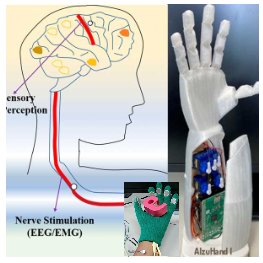Neuromorphic AI Circuits and
Systems
Members:
Abderazek Ben Abdallah (PI), Dang Nam
Khanh (Co-PI)
We are
exploring the development of an adaptive ultra-low
power neuromorphic chip (NASH), enhanced by our
previously developed fault-tolerant
three-dimensional on-chip interconnect technology.
The NASH system boasts several features, including
an efficient adaptive configuration method that
enables the reconfiguration of various SNN
parameters such as spike weights, routing, hidden
layers, and top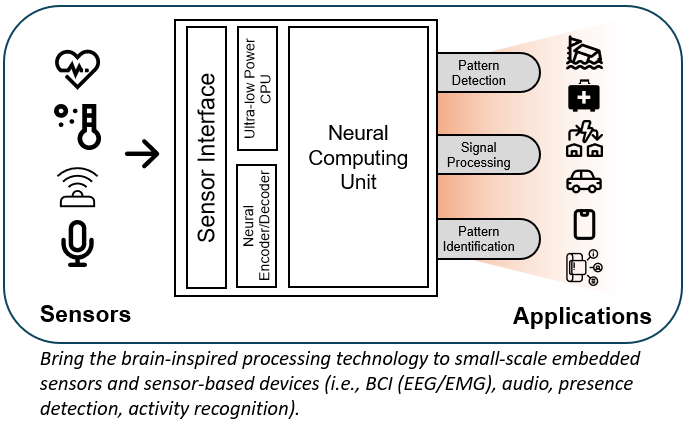 ology.
Additionally, the system incorporates a blend of
different deep neural network topologies, an
efficient fault-tolerant multicast spike routing
algorithm, and an effective on-chip learning
mechanism. To demonstrate the performance of the
NASH system, we will develop an FPGA
implementation and establish a VLSI
implementation. ology.
Additionally, the system incorporates a blend of
different deep neural network topologies, an
efficient fault-tolerant multicast spike routing
algorithm, and an effective on-chip learning
mechanism. To demonstrate the performance of the
NASH system, we will develop an FPGA
implementation and establish a VLSI
implementation.
The ultimate goal of NASH SoCs is to bring
brain-inspired processing technology to
small-scale embedded sensors and sensor-based
devices, such as BCI (EEG/EMG), audio, presence
detection, and activity recognition.
Applications Areas:
- Robot
safety, human-robot interaction, adaptive
prosthertics
- Assistive
robotics in healthcare and smart
environments
- Machine
vision and learning in adaptive systems
-
Ryoji
Kobayashi1, Ngo-Doanh Nguyen, Abderazek
Ben Abdallah, Nguyen Anh Vu Doan and
Khanh N. Dang, "ApproxiMorph:
Energy-efficient Neuromorphic System
with Layer-wise Approximation of Spiking
Neural Networks and 3D-Stacked SRAM", in
IEEE Transactions on Computer-Aided
Design of Integrated Circuits and
Systems, doi: 10.1109/TCAD.2025.3597251.
ApproxiMorph is a
software-hardware co-design framework for
energy-efficient AI on 3D-IC-based
neuromorphic systems. It leverages 3D-IC
parallelism and SNN noise resilience to
reduce power via: (1) approximate neuron
design, (2) heuristic layer-wise SNN
approximation, (3) low-voltage 3D-stacked
SRAM, and (4) weight tuning. ApproxiMorph
explores only 0.44–0.67% of
configurations, saving 28.06% power with
0.60% accuracy loss on MNIST. For VGG16 on
CIFAR-10, it searches ~10³ of 10¹⁷
options, achieving 29.16% power savings
with slight accuracy gain. Combined
techniques improve approximation accuracy
and error resilience beyond exact
implementations.
- M. Maatar, Z. Wang, K. N. Dang
and A. B. Abdallah, "BTSAM:
Balanced Thermal-State-Aware Mapping
Algorithms and Architecture for
3D-NoC-B
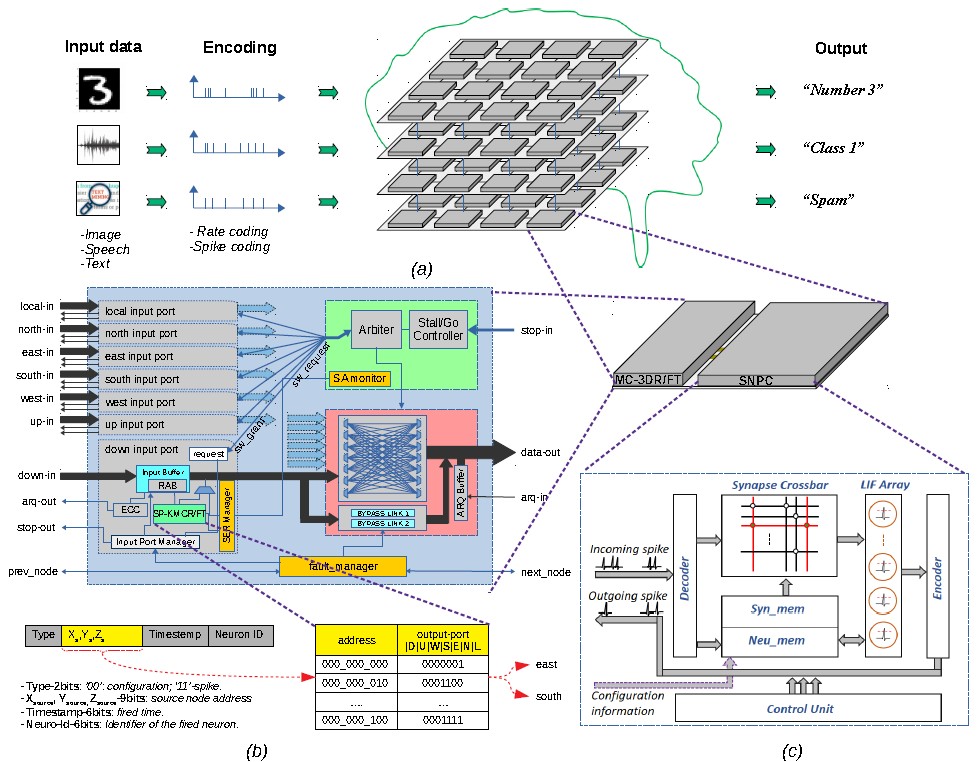 ased
Neuromorphic Systems,"
in IEEE Access, doi:
10.1109/ACCESS.2024.3425900. ased
Neuromorphic Systems,"
in IEEE Access, doi:
10.1109/ACCESS.2024.3425900.
keywords:
{Neuromorphics;Neurons;Synapses;Three-dimensional
displays;Routing;Task analysis;Heat
sinks;Neuromorphic
Systems;Mapping;Thermal-State-Aware;3D-NoC;Genetic
Algorithm}
Neuromorphic computing systems are
biologically inspired approaches created
from many highly connected neurons to
model neuroscience theories and solve
machine learning problems. They promise
to drastically improve the efficiency of
critical computational tasks such as
decision-making and
perception. Combining neuromorphic
computing systems and 3D interconnect
technology leads to an advanced
architecture that inherits the benefits
of both computing and interconnect
paradigms. However, designing
large-scale neuromorphic systems based
on 3D-NoC faces several challenges,
including thermal power, power
distribution, cooling systems, and
fabrication requirements. This work
tackles the thermal issues in designing
large-scale neuromorphic systems by
proposing a Balanced Thermal-State-Aware
Mapping (BTSAM) for 3D-NoC-based
neuromorphic systems. This includes a
Periodic Activity Scoring (PAS), a
Seesaw Neuron Clustering (SNC) method,
and a thermal-aware genetic algorithm to
eliminate hotspots, balance the thermal
state, and lower the temperature
while keeping the system’s accuracy
acceptable. Evaluation results on
various system configurations
demonstrate a notable up to 5K
temperature reduction and a 4× increase
in Mean-Time-to-Failure (MTTF) compared
to linear methods, with little
degradation in communication cost.
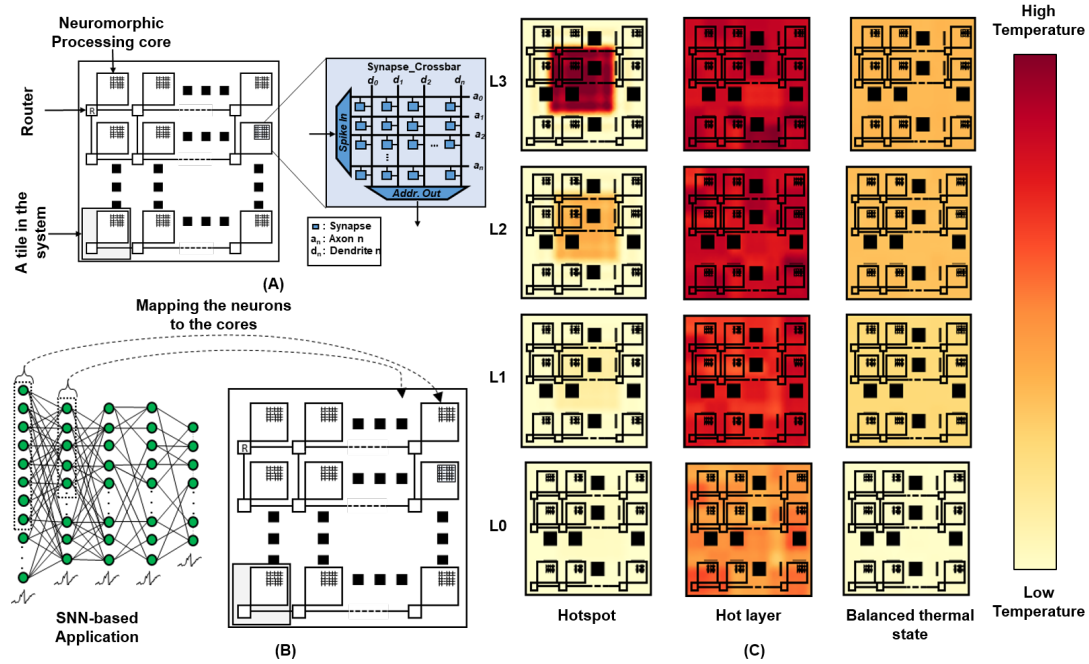
- Ngo-Doanh
Nguyen, Akram Ben Ahmed, Abderazek Ben
Abdallah, Khanh N. Dang, "Power-aware
Neuromorphic Architecture with Partial
Voltage Scaling 3D Stacking Synaptic Memory"
in IEEE Transactions on Very Large Scale
Integration Systems (TVLSI), Q3, 2023.
The combination of neuromorphic computing (NC)
and 3-D integrated circuits - the 3-D stacking
neuromorphic system can be the most advanced
architecture that inherits the benefits of both
computing and interconnect paradigms. However,
simply shifting to the third dimension cannot
exploit the 3-D structure and also end up with a
low yield rate issue. Therefore, in this
article, we propose a methodology to design 3-D
stacking synaptic memory for power-efficient
operations and yield rate improvement of
neuromorphic systems. In this proposed
methodology, the synaptic weights are stacked on
top of the processing elements (PEs), and these
weights are split into multiple subsets placed
in different layers. Furthermore, with the
support of 3-D technology, the supply voltage of
each layer can be controlled independently which
leads to power reduction by scaling down or
turning off the supply voltage of the memory
layer(s) containing the least significant bits
(LSBs) while maintaining acceptable accuracy. On
top of that, this work also proposes a
methodology to deal with the low yield rate
issue by treating the defective memory cells as
noises. In our evaluation with the CMOS 45 nm
technology, the energy per synaptic operation
(SOP) for MNIST classification, when
undervolting two upper memory layers (from 1.1
to 0.8 V), reduces by 21.62% while the accuracy
only reduces sightly by 0.51%. This energy
reduction increases to 66.77% with 6.58%
accuracy loss when our system uses both
power-gating and undervolting for all memory
layers. Furthermore, the system can also improve
the yield rate by 0.18% or 12.4% while suffering
0.38% or 1.7% of accuracy loss, respectively.
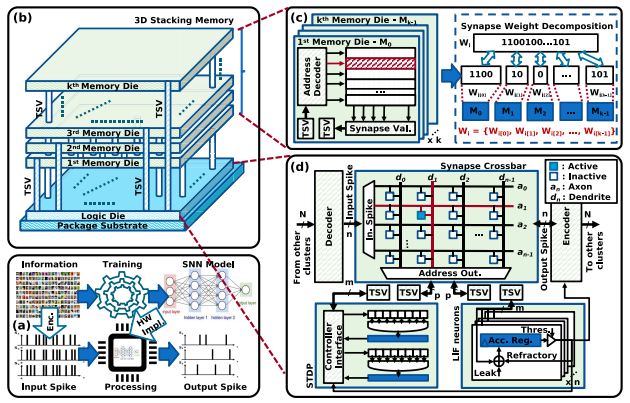
- W.
Y. Yerima, K. N. Dang and A. B. Abdallah,
"R-MaS3N: Robust Mapping of Spiking Neural
Networks to 3D-NoC-Based Neuromorphic
Systems for Enhanced Reliability," in IEEE
Access, doi: 10.1109/ACCESS.2023.3311031
Neuromorphic computing utilizes
spiking neural networks (SNNs) to offer
power/energy-efficient solutions for complex
machine-learning problems in hardware. However,
neural circuits are prone to faults caused by
variability in the manufacturing flow, process
variations, and manufacturing defects. This work
proposes a mapping approach, R-MaS3N, that
leverages the reuse of existing neurons for
robust mapping of SNNs to a 3D-NoC-based
neuromorphic system (NR-NASH). A heuristic-based
partitioning technique is employed to partition
neurons in the layers of an SNN application
using neuron firing patterns. Moreover, a
neuronal partitioning approach cluster mapped
neurons in the layers of the neuromorphic neural
circuits based on connectivity patterns and
spiking activities. Evaluation results show that
the proposed fault-tolerant mapping method
maintains a remapping efficiency of 100% with a
fault rate of 40% in the 3D NoC-based
neuromorphic system. With a NoC system
configuration of 4×4×4 and
256 neurons per cluster, our approach has a
remapping time of 71× less
than the previous approach with the same NoC
system configuration parameters. In addition,
the mean time to failure (MTTF) of the mapping
method for system configuration 5×5×5 NoC
size at a 40% fault rate surpasses the previous
method at 20% fault rate by 16% for 4×4×4 NoC
size.
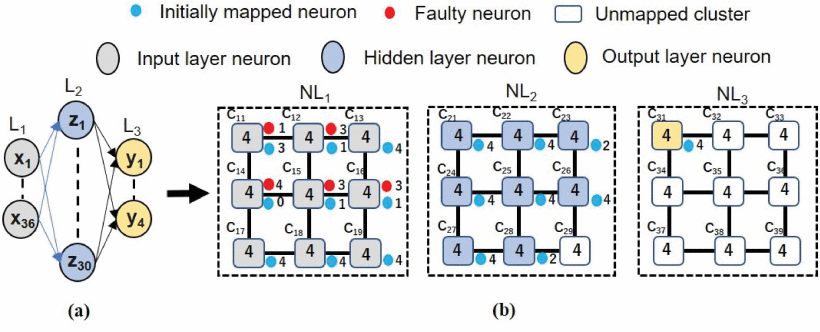
- Ngo-Doanh
Nguyen, Xuan-Tu Tran, Abderazek Ben Abdallah
and Khanh N. Dang, "An In-situ Dynamic
Quantization with 3D Stacking Synaptic Memory
for Power-aware Neuromorphic Architecture,"
in IEEE Access, DOI:
10.1109/ACCESS.2023.3301560
Spiking Neural Networks (SNNs) show their
potential for lightweight low-power inferences
because they mimic the functionality of the
biological brain. However, one of the major
challenges of SNNs like other neural networks is
memory-wall and power-wall when accessing data
(synaptic weights) from memory. It limits the
potential of spiking neural networks implemented
on edge devices. In this paper, we present a
novel spiking computing hardware architecture
named NASH-3DM using 3D-IC-based stacking memory
with power supply awareness to effectively
decrease power consumption for AI-enabled edge
devices. Instead of storing one or multiple
weights in a single memory word, we split them
into small subsets and allocate each subset into
a separate memory in every stacking layer. With
the natural separation of stack layers, our
system can activate and deactivate each layer
separately. Therefore, it can offer in-situ
(online, post-manufacture, and without
interruption) dynamic quantization with multiple
operating modes. With the CMOS 45nm technology,
our energy per synaptic operation for MNIST
classification can reduce by 36.67% while having
0.93%-1.14% accuracy loss at 5-bit quantization.
The energy per synaptic operation reduction for
the CIFAR10 dataset is 36.68% when switching
from the 16-bit active operation to the in-situ
10-bit one with an accuracy loss of 5.69%.
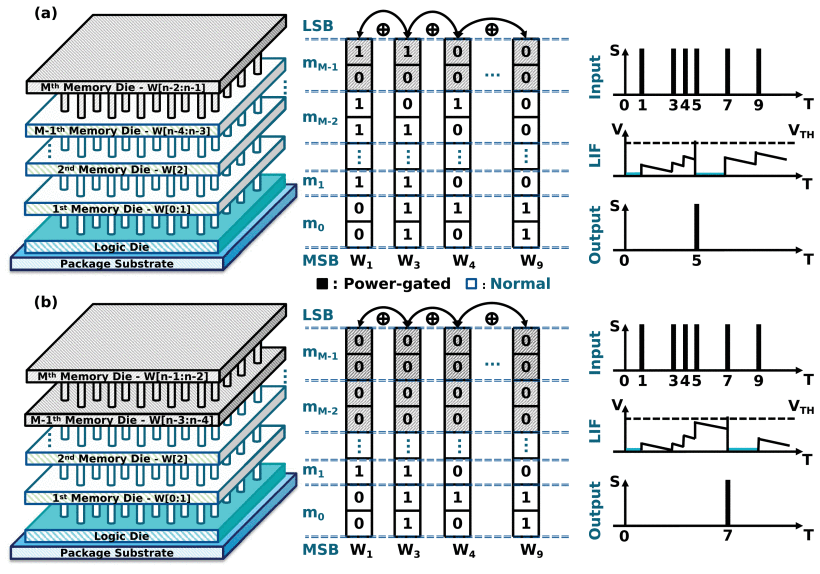
-
W.
Y. Yerima, O. M. Ikechukwu, K. N. Dang
and A. Ben Abdallah, "Fault-Tolerant
Spiking Neural Network Mapping Algorithm
and Architecture to 3D-NoC-Based
Neuromorphic Systems," in IEEE
Access, vol. 11, pp. 52429-52443, 2023,
doi: 10.1109/ACCESS.2023.3278802.
Neuromorphic computing uses spiking
neuron network models to solve machine
learning problems in a more
energy-efficient way when compared to
conventional artificial neural networks.
However, mapping the various network
components to the neuromorphic hardware is
not trivial to realize the desired model
for an actual simulation. Moreover,
neurons and synapses could be affected by
noise due to external interference or
random actions of other components (i.e.,
neurons), which eventually lead to
unreliable results. This work proposes a
fault-tolerant spiking neural network
mapping algorithm and architecture to a 3D
network-on-chip (NoC)-based neuromorphic
system (R-NASH-II) based on a rank and
selection mapping mechanism (RSM). The RSM
allows the ranking and rapid selection of
neurons for fault-tolerant mapping.
Evaluation results show that with our
proposed mechanism, we could maintain a
mapping efficiency of 100% with 20% spare
rate and a fault rate (40%) more than in
the previous mapping framework. The Monte
Carlo simulation evaluation of reliability
shows that the RSM mechanism has increased
the mean time to failure (MTTF) of the
previous mapping technique by 43% on
average. Furthermore, the operational
availability of the RSM for mapping to
a 4×4×4 (smallest)
and 6×6×6 (largest)
NoC is 88% and 67% respectively.
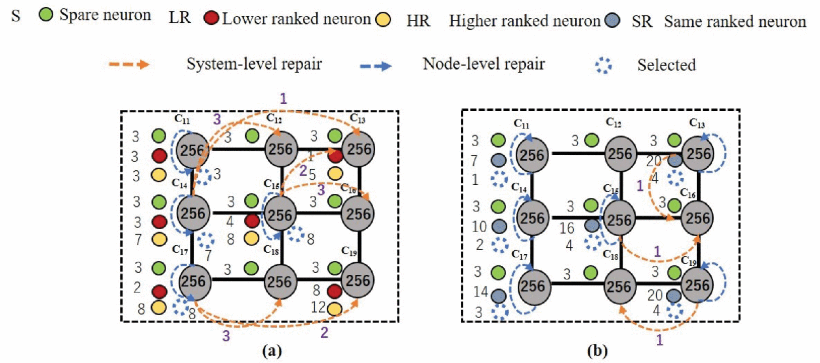
-
Abderazek
Ben Abdallah, Khanh N.
Dang, ''Toward Robust Cognitive 3D
Brain-inspired Cross-paradigm
System,'' Frontier in Neuroscience
15:690208, doi:
10.3389/fnins.2021.690208
Spiking
Neuromorphic systems have been
introduced as promising platforms for
energy-efficient spiking neural network
(SNNs) execution. SNNs incorporate
neuronal and synaptic states in addition
to the variant time scale into their
computational model. Since each neuron
in these networks is connected to many
others, high bandwidth is required.
Moreover, since the spike times are used
to encode information in SNN, a precise
communication latency is also needed,
although SNN is tolerant to the spike
delay variation in some limits when it
is seen as a whole. The two-dimensional
packet-switched network-on-chip was
proposed as a solution to provide a
scalable interconnect fabric in
large-scale spike-based neural networks.
The 3D-ICs have also attracted a lot of
attention as a potential solution to
resolve the interconnect bottleneck.
Combining these two emerging
technologies provides a new horizon for
IC design to satisfy the high
requirements of low power and small
footprint in emerging AI applications.
Moreover, although fault-tolerance is a
natural feature of biological systems,
integrating many computation and memory
units into neuromorphic chips confronts
the reliability issue, where a defective
part can affect the overall system's
performance. This paper presents the
design and simulation of R-NASH-a
reliable three-dimensional digital
neuromorphic system geared explicitly
toward the 3D-ICs biological brain's
three-dimensional structure, where
information in the network is
represented by sparse patterns of spike
timing and learning is based on the
local spike-timing-dependent-plasticity
rule. Our platform enables high
integration density and small spike
delay of spiking networks and features a
scalable design. R-NASH is a design
based on the Through-Silicon-Via
technology, facilitating spiking neural
network implementation on clustered
neurons based on Network-on-Chip. We
provide a memory interface with the host
CPU, allowing for online training and
inference of spiking neural networks.
Moreover, R-NASH supports fault recovery
with graceful performance degradation.

-
Khanh
N. Dang, Nguyen Anh Vu Doan, Abderazek
Ben Abdallah “MigSpike: A Migration
Based Algorithm and Architecture for
Scalable Robust Neuromorphic
Systems,” IEEE Transactions
on Emerging Topics in
Computing (TETC), 12/2021. DOI:
10.1109/TETC.2021.3136028
While conventional hardware
neuromorphic systems usually consist of
multiple clusters of neurons that
communicate via an interconnect
infrastructure, scaling up them confronts
the reliability issue when faults in the
neuron circuits and synaptic weight
memories can cause faulty outputs. This
work presents a method
named MigSpike that allows
placing spare neurons for repairing with
the support of enhanced migrating methods
and the built-in hardware architecture for
migrating neurons between nodes (clusters
of
neurons). MigSpike architecture
supports migrating the unmapped neurons
from their nodes to suitable ones within
the system by creating chains of
migrations. Furthermore, a max-flow
min-cut adaptation and a genetic algorithm
approach are presented to solve the
aforementioned problem. The evaluation
results show that the proposed methods
support recovery up to 100% of spare
neurons. While the max-flow min-cut
adaption can execute milliseconds, the
genetic algorithm can help reduce the
migration cost with a graceful degradation
on communication cost. With a system of
256 neurons per node and a 20% fault rate,
our approach minimizes the migration cost
from remapping by 10.19× and 96.13× under
Networks-on-Chip of 4×4 (smallest)
and 16×16×16 (largest),
respectively. The Mean-Time-to-Failure
evaluation also shows an approximate 10×
of lifetime expectancy by having a 20%
spare rate.

-
O.
M. Ikechukwu, K. N. Dang and A. Ben
Abdallah, ''On the Design of a
Fault-Tolerant Scalable Three
Dimensional NoC-Based Digital
Neuromorphic System With On-Chip
Learning,'' IEEE Access, vol. 9,
pp. 64331-64345, 2021, doi:
10.1109/ACCESS.2021.3071089
Neuromorphic systems have shown
improvements over the years, leveraging
Spiking neural networks (SNN) event-driven
nature to demonstrate low power
consumption. As neuromorphic systems
require high integration to form a
functional silicon brain-like, moving to
3D integrated circuits (3D-ICs) with
three-dimensional network on chip (3D-NoC)
interconnect is a suitable approach that
allows scalable design, shorter
connections, and lower power consumption.
However, highly dense neuromorphic systems
also encounter the reliability issue where
a single point of failure can affect the
systems'operation. Because neuromorphic
systems rely heavily on spike
communication, an interruption or
violation in the timing of spike
communication can adversely affect the
performance and accuracy of a neuromorphic
system. This paper presents
NASH, a a fault-tolerant 3D-NoC
based neuromorphic system that
incorporates as processing elements,
lightweight spiking neuron processing
cores (SNPCs) with
spike-timing-dependent-plasticity (STDP)
on-chip learning. Each SNPC houses 256
leaky integrate-and-fire (LIF) neurons and
65k synapses. Evaluation results on MNIST
classification, using the fault-tolerant
shortest-path K-means-based multicast
routing algorithm (FTSP-KMCR), show that
the NASH system can maintain high accuracy
for up to 30% permanent fault in the
interconnect with an acceptable area and
power overheads when compared to other
existing systems.

-
The
H. Vu,Yuichi Okuyama, Abderazek Ben
Abdallah, '' Comprehensive Analytic
Performance Assessment and K-means based
Multicast Routing Algorithms and
Architecture for 3D-NoC of Spiking
Neurons.,'' ACM Journal on Emerging
Technologies in Computing Systems
(JETC), Vol. 15, No. 4, Article 34,
October 2019. doi: 10.1145/3340963
Spiking neural networks (SNNs) are
artificial neural network models that more
closely mimic biological neural networks.
In addition to neuronal and synaptic
state, SNNs incorporate the variant time
scale into their computational model.
Since each neuron in these networks is
connected to thousands of others, high
bandwidth is required. Moreover, since the
spike times are used to encode information
in SNN, very low communication latency is
also needed. The 2D-NoC was used as a
solution to provide a scalable
interconnection fabric in large-scale
parallel SNN systems. The 3D-ICs have also
attracted a lot of attention as a
potential solution to resolve the
interconnect bottleneck. The combination
of these two emerging technologies
provides a new horizon for IC designs to
satisfy the high requirements of low power
and small footprint in emerging AI
applications. In this work, we first
present a comprehensive analytical model
to analyze the performance of 3D mesh NoC
over variants of different SNN topologies
and communications protocols. Second, we
present an architecture and a low-latency
spike routing algorithm, named shortest
path K-means based multicast (SP-KMCR),
for three-dimensional NoC of spiking
neurons (3DNoC-SNN). The proposed system
was validated based on an RTL-level
implementation, while area/power analysis
was performed using 45nm CMOS technology.

-
The
Vu, Ogbodo Mark Ikechukwu, Abderazek Ben
Abdallah, ''Fault-tolerant Spike Routing
Algorithm and Architecture for Three
Dimensional NoC-Based Neuromorphic
Systems'', IEEE Access, Vol 7,
pp. 90436-90452, 2019,
DOI: 10.1109/ACCESS.2019.2925085
Neuromorphic computing systems are an
emerging field that takes its inspiration
from the biological neural architectures
and computations inside the mammalian
nervous system. The spiking neural
networks (SNNs) mimic real biological
neural networks by conveying information
through the communication of short pulses
between neurons. Since each neuron in
these networks is connected to thousands
of others, high bandwidth is required.
Moreover, since the spike times are used
to encode information in SNN, very low
communication latency is also necessary.
On the other hand, the combination of
Two-dimensional Networks-on-Chip (2D-NoC)
and Three-dimensional Integrated Circuits
(3D-ICs) can provide a scalable
interconnection fabric in large-scale
parallel SNN systems. Although the SNNs
have some intrinsic fault-tolerance
properties, they are still susceptible to
a significant amount of faults;
especially, when we talk about integrating
the large-scale SNN models in hardware.
Consequently, the need for efficient
solutions capable of avoiding any
malfunctions or inaccuracies, as well as
early fault-tolerance assessment, is
becoming increasingly necessary for the
design of future large-scale reliable
neuromorphic systems. This paper first
presents an analytical model to assess the
effect of faulty connections on the
performance of a 3D-NoC-based spiking
neural network under different neural
network topologies. Second, we present a
fault-tolerant shortest-path k-means-based
multicast routing algorithm (FTSP-KMCR)
and architecture for spike routing in
3D-NoC of spiking neurons (3DFT-SNN).
Evaluation results show that the proposed
SP-KMCR algorithm reduces the average
latency by 12.2% when compared to the
previously proposed algorithm. In
addition, the proposed fault-tolerant
methodology enables the system to sustain
correct traffic communication with a fault
rate up to 20%, while only suffering
16.23% longer latency and 5.49% extra area
cost when compared to the baseline
architectures

- 特
許第7277682号 (May 11, 2023)Abderazek Ben
Abdallah, The H. Vu, Masayuki Hisada, 3次元ネット
ワークオンチップによるスパイキング ニューラルネットワーク】 ''Spiking
Neural Network with 3D Network-on-Chip'',
特願2019-124541 (July 3, 2019)
Other related research
|


